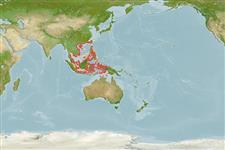Actinopterygii (ray-finned fishes) >
Tetraodontiformes (Puffers and filefishes) >
Monacanthidae (Filefishes)
Etymology: Paramonacanthus: Greek, para = the side of + Greek, monos = one + Greek, akantha ) thorn (Ref. 45335).
Environment / Climate / Range
Ecology
Marine; benthopelagic; depth range 15 - 50 m (Ref. 90102). Temperate, preferred ?; 25°N - 11°S, 95°E - 141°E
Western Pacific: South China Sea and Java Sea.
Size / Weight / Age
Maturity: Lm ? range ? - ? cm
Max length : 20.0 cm SL male/unsexed; (Ref. 48637)
Short description
Morphology | Morphometrics
Dorsal
spines
(total): 2;
Dorsal
soft rays
(total): 30-33;
Anal
spines: 0;
Anal
soft rays: 31 - 34;
Vertebrae: 19. Body width 2.1-2.5 in head length; body depth 1.9-2.5 in SL; head length 2.8-3.1 in SL; snout length 4.1-4.5 in SL; eye diameter 2.7-3.9 in head length. Spinules forming prominent longitudinal series on side of body (Ref. 33065).
Inhabits muddy substrates in sheltered coastal bays (Ref. 48637). Also found in sand bottoms of trawling grounds in 15-50 m (Ref. 90102).
Life cycle and mating behavior
Maturity | Reproduction | Spawning | Eggs | Fecundity | Larvae
Hutchins, J.B., 1997. Review of the monacanthid fish genus Paramonacanthus, with descriptions of three new species. Rec. West. Aust. Mus. Suppl. No. 54:1-57. (Ref. 33065)
IUCN Red List Status (Ref. 115185)
CITES (Ref. 94142)
Not Evaluated
Threat to humans
Harmless
Human uses
More information
Common namesSynonymsMetabolismPredatorsEcotoxicologyReproductionMaturitySpawningFecundityEggsEgg development
Age/SizeGrowthLength-weightLength-lengthLength-frequenciesMorphometricsMorphologyLarvaeLarval dynamicsRecruitmentAbundance
ReferencesAquacultureAquaculture profileStrainsGeneticsAllele frequenciesHeritabilityDiseasesProcessingMass conversion
Tools
Special reports
Download XML
Internet sources
